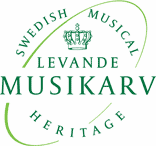August Söderman (1832−1876)
Hin Ondes Lärospån. Legend i en Akt [Legend in one Act] (Hin Ondes första Lärospån)
- Year of composition: Score dated 4 June 1856, overture dated Skokloster 3 July 1856
- Work category: Operetta / Comic opera
- Text author: Eugène Scribe (Le Diable à l'école, 1842), the lyrics freely adapted by Fritz Arlberg
- First performed: 14 September 1856 at the Mindre Teatern [The Smaller Theatre], Stockholm
- Duration: Approx. 40-50 min
- Detailed duration: Playing time unknown
Instrumentation
2.2.2.2 / 2.2.1.0 / timp / str
Solo voices/choir
Stenio, young merchant in Venice (tenor)
Fiamma, his servant (soprano)
Babylas (baritone)
1 soprano (Fiamma), 1 tenor (Stenio), 1 baritone (Babylas)
(no choir)
Examples of printed editions
No. 1. Romance: Abr. Hirsch, Ed. no. 1451 (= Hirsch no. 1)
No. 3. Duett: Abr. Hirsch, Ed. no. 1452 (= Hirsch no. 2)
No. 5. Kupletter [Cuplés]: Abr. Hirsch, Ed. no. 1453 (= Hirsch no. 3)
(According to the cover pages of the sheet music, the duet no. 3 1/2 was published as Hirsch no. 4, but this print is missing from the collections of the Musik- och teaterbiblioteket)
Location for score and part material
A handwritten prompt book and orchestral parts can be found at the Musik- och teaterbiblioteket (Kungl. Teatern, Operetter H18 [The Royal Theatre/Opera, Operettas H18]), where there is also a handwritten libretto in Dep. I, kuvert [envelope] no. 9
- Location autograph: Musik- och teaterbiblioteket
- Possible call no. and autograph comment: Z/Sv (score to the overture, piano reduction to No. 1 Romance, No. 3 Duett, No. 5 Kupletter [Cuplés])
Literature
Jeanson, Gunnar: August Söderman. En svensk tondiktares liv och verk, 1926
Description of work
Overture: Allegro con brio C major alla breve
The stage shows a garden by Stenio's villa. To the right, there is a pavillion. Stone tables to the right and left. In a niche in the pavillion there is a Madonna sculpture.
Scene 1: Pensive, Stenio is sitting at the table to the left. After the song, he returns to his pensive mood. Stenio
Scene 2: Fiamma enters, bearing a basked of flowers. She approaches Stenio and touches his shoulder. Stenio, Fiamma
Scene 3: Fiamma alone. During the ritornello she watches Stenio leaving. She then approaches the Madonna sculpture and kneels. Fiamma, Stenio
Scene 4: Babylas enters. Fiamma, Babylas
Scene 5: Fiamma (alone), thereafter Stenio. Fiamma, Stenio
Scene 6: On perceiving Babylas, Fiamma screems, buries her face in her hands and flees. Fiamma, Babylas, Stenio
Scene 7: Babylas (alone), thereafter Fiamma. Babylas, Fiamma
Scene 8: Fiamma, Stenio
Libretto/text
No. 1. Romance: Hvad lifvet dock är skönt, hur herlig står naturen
I glansen af Gud Faders klara sol! (Stenio)
No. 2. Preghiera [prayer]: Helga jungfru låg min svaga stämma (Fiamma)
No. 3. Duet: Ser du den? Nå än se'n? Tag den blott och du skall finna
Hvad mäktig tjusningskraft den ger (Babylas, Fiamma)
No. 3 1/2. Scene och Duett: Min Gud! hvad hör jag redan denna dag (Fiamma, Stenio)
No. 4. Duet: Mig tycks, du kan din älskarinna med nöje för sin spegel finna (Babylas, Stenio)
No. 5. Couplets [Cuplés]: Fordom ju beständigt, för kamraters gäckeri ett föremål jag blef (Babylas)
No. 6. Duet: Ett enda medel finns, att Stenio från förderfvet rycka (Babylas, Fiamma)
No. 7. Finale: Han frälsad är min Gud jag tackar dig (Fiamma, Stenio, Babylas)

